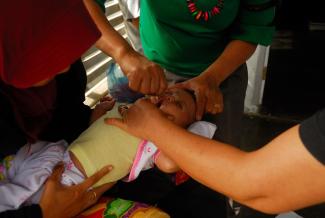MDGs
Think globally, act globally

The MDGs mark a unique spot in the history of development cooperation. Their legacy for cooperation, inspiring shared vision and sense of responsibilities is unprecedented. They brought about a paradigm shift in cooperation between sovereign partners who otherwise would have pursued different interests and priorities. With the adoption of the MDGs in 2000, the world for the first time acted outside the tradition of signing treaties and conventions by appraising a global action plan with defined targets.
The agenda aimed to curb abject poverty and thus introduced an integrated development approach, which would be instrumental for the implementation of the set of goals comprehensively and simultaneously.
The MDGs significantly shaped our thoughts. They promoted policy convergence through a shared vision and the introduction of new global values and partnership modalities. Taking into account challenges humanity faces on the globe and attempting to resolve them seamlessly was the defining principle.
Recognising the increasing interface between nations through globalisation in the 1980s and 90s, the international community had for the first time determined that untimeliness will be the potential factor to jeopardise all the gains and booms of the civilised world. Thus, no matter where and how challenges occur, we are all responsible for the cause and solution – while also implying the need for doing things differently and urgently.
The MDGs went beyond inspirational slogans and wishes. They had clear targets to be delivered in a defined target space. This shift also helped to alter the old view of “think globally, act locally” by emphasising the need to act globally – along with the thinking. Some global acts worth mentioning within the MDG process were:
- establishing a global fund for supporting different MDG goals,
- worldwide debate on experiences and programmes and
- establishing standards for rating and evaluation.
Successful fight against poverty
Notwithstanding its wide adaptation, the MDGs’ impact and performance varied between countries and across the goals. Compared to the 1990s’ baselines, dozens of countries in Africa and Asia made substantial progress in the fight against poverty and lifted millions of people out of the poverty trap. Almost as many people benefited from “quick win” issues such as:
- improving primary education enrolment,
- narrowing gender disparity,
- reducing under five, neo-natal and maternal mortalities and
- controlling communicable diseases such as tuberculosis, Malaria and HIV/AIDS.
On the downside, the gains tended to be quite volatile. Too little was done to build a proper system to sustain them. The lesson is that concerted action can make a difference, but long-term durability requires appropriate institutions.
In regard to governance and implementation, there were several weak links and loopholes in all stages of setting the MDG agenda and building capacities for implementation, monitoring and evaluation. The entire process was mostly pre-defined and did not benefit much from the global debate that accompanied it. Things are supposed to work out better for the SDGs.
A core lesson is that the MDGs were not multifaceted enough. They were not comprehensive in the sense of bringing about the needed transformational changes. Due to their focus on certain quick-impact areas, the MDGs tended to neglect fundamental issues such as climate change and inequality. Consequently, the progress made brought less satisfaction than was hoped.
Barely any attention was given to the question how to multiply and scale up success stories. As is widely recognised now, coordinated investments in health, education, agriculture and infrastructure create important synergies. Good performance in agriculture goes hand in hand with the effort for better nutrition, and girls’ secondary education helps to reduce population growth. Healthier children learn better and attend school more reliably; schools teach health-promoting activities; infrastructure such as electrification and clean water enhance both health and education. Failures in one sector, on the other hand, have negative impacts on all other sectors.
Furthermore, the international donor community embarrassingly failed to follow through on its commitment to raise official development assistance (ODA) to 0.7 % of GNI. The group of 29 donor countries of the Organisation for Economic Co-operation and Development (OECD) had an ODA rate of only 0.32 % of their combined GNI in 2016. That signified an annual shortfall in aid of roughly $ 170 billion. This lack of ODA radically limited the financial capacity of MDG implementation in developing countries.
Challenges for the new agenda
The 2030 Agenda calls for societal transformation. Its ambition is beyond addressing poverty in the national socio-economic context. The goal is to save the planet. Sustainable development is about sharing benefits and building resilience. Humanity needs economic growth within the planetary boundaries without leaving anyone behind.
However, the SDGs themselves have met with considerable criticism. Important points range from the half-baked concept to implementation constraints and unclarities of the governance system. Though specific goals and targets are defined clearly, the pathways that are needed to achieve them are not. Hence, it is essential to ensure that development paths chosen for implementations are technically feasible, financially affordable and – most important – not environmentally harmful. Those in charge must therefore rise to massive challenges.
Belay Begashaw is director general of the Sustainable Development Goals Center for Africa (SDGC/A) in Kigali, Rwanda.
bbegashaw@sdgcafrica.org












